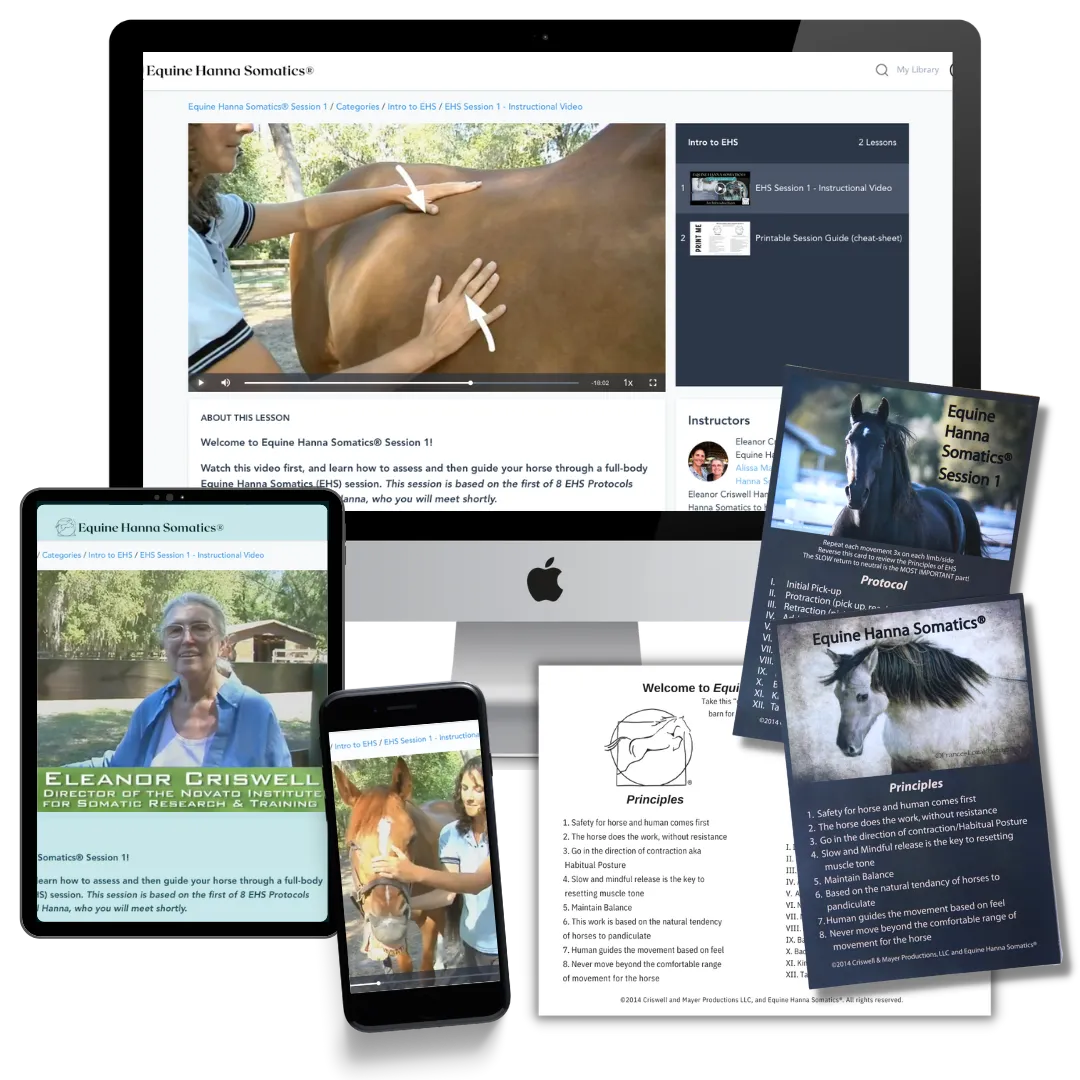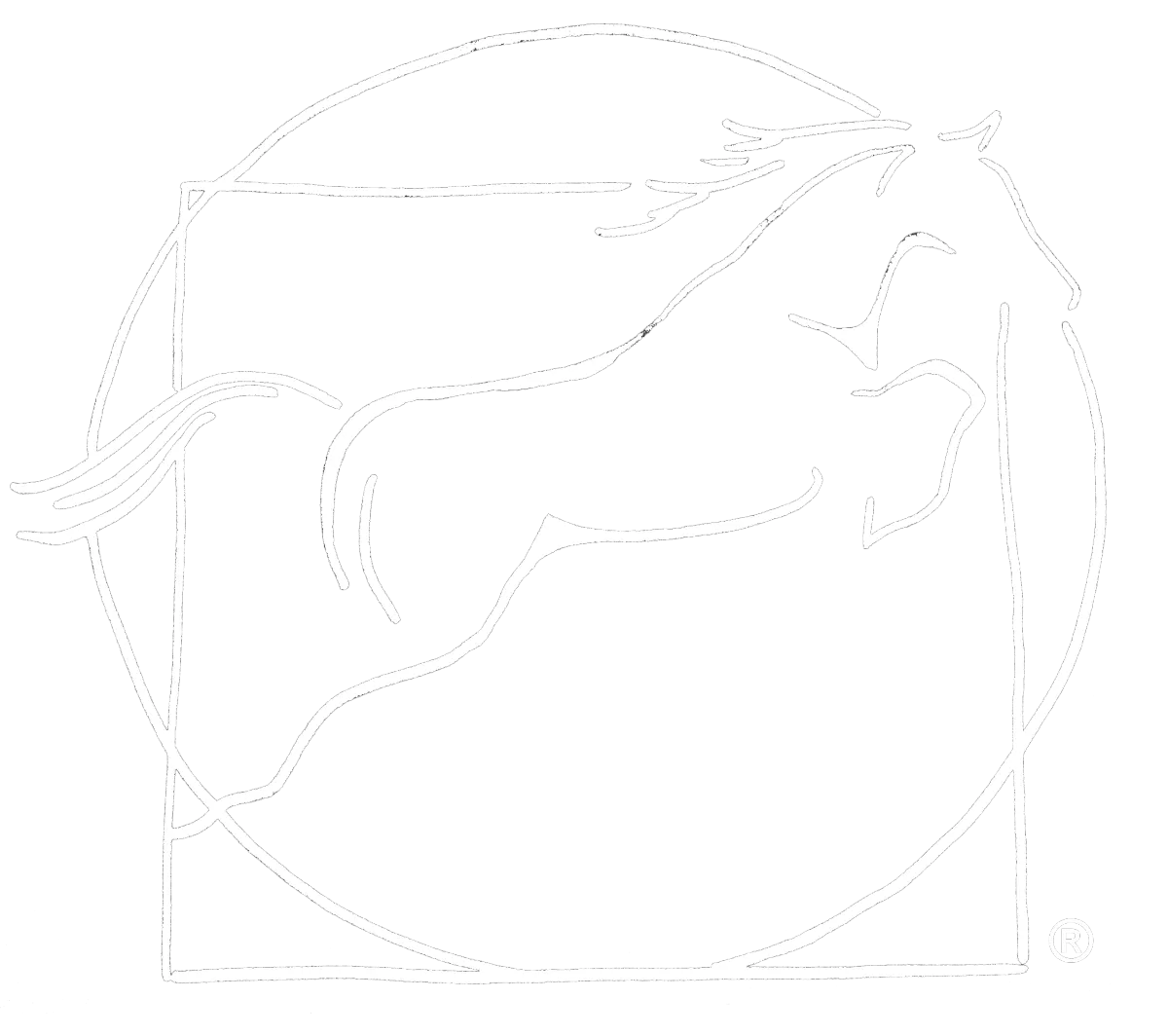Equine Brachiocephalic Muscles (part 2)
This article follows up on a previous blog post discussing Equine Brachiocephalic Muscles. In this 'part 2' learn why why simply putting a horses head down is not enough!
So many horses are suffering with chronic tension in their ventral neck and thoracic sling muscles, and I was just asked if our EHS Session 1 Protocol (from our intro course) can help and how often it needs to be repeated to get or maintain results…
Below is my answer, and then come along with me down the rabbit-hole discussing what is really at the root of an ‘upside-down’ or ewe neck, why solving tension in just the brachiocephalic muscles is NOT enough to help most horses get free from this postural compensation, and what is possible when we address habitual tension in the whole horse, somatically.
Can Equine Hanna Somatics reverse tight brachiocephalic muscles in a horse?
For many horses, the exercises in our Equine Hanna Somatics® Session 1 intro course are enough to completely resolve chronic tension in the brachiocephalic muscles AND keep it from coming back by also addressing the root cause of their compensatory posture. Horses with 'upside-down necks' nearly always have a body-wide pattern of chronic habitual muscle tension that puts them in a posture of spinal extension (hollow back with a high head/neck position and often also camped out limbs and 'dropped' thoracic sling).
Have a look at the illustration by Dr. Deb Bennett below at what happens in the horses whole body when they are able to have a neutral posture and spine vs. what happens when they have a posture that puts them in either spinal extension or spinal flexion. (However, I must add that while this article describes muscles as only being able to lengthen when mechanically stretched (by outside forces or internal contractions of opposing muscles), it is missing a very important element of muscle function - that muscles also do eccentric contractions, in which they are gradually lengthening against a load (or against gravity) by "shortening less" over an over, which is achieved by inhibitory motor impulses... and that this can and should occur as part of normal, healthy movement, and especially during the slow return to neutral after each EHS exercise!)

You do not need to do Equine Hanna Somatics exercises every day - when done correctly they have the immediate and semi-permanent effect of the horse resetting their resting muscle tone closer to neutral each time they do the exercises. We usually recommend doing the basic full-body session daily for 3 days, once a week for 3 weeks, and then only as needed, or as monthly maintenance and for prevention thereafter. In my experience and professional estimation, this is sufficient for about 60% of horses.
For the other 40% of horses, they frequently have a more complex layering of learned compensatory muscle contractions, and require further assistance in UN-learning those patterns in the order they present - which we do with our more specialized EHS protocols designed to address specific somatic issues and areas of the horses neuromuscular system (these are what we teach in our EHS Professional Training Program).
Hypertonic vs. Hypertrophic Ventral Neck Muscles
If the ventral neck muscles are not just chronically contracted (ie. have elevated resting muscle tone aka are hypertonic aka are tight) but are also overdeveloped (ie. have been under load or strain repeatedly over time and have grown more and stronger muscle fibers in response to the long-term stress - aka hypertrophic) then we have two things contributing to the appearance of the upside-down neck on a horse.
It's important to note that a muscle can be hypertrophic WITHOUT being hypertonic (they can be overdeveloped and have healthy tone, or can be overdeveloped and have elevated tone).
Healthy resting muscle tone means that the muscle is only activated to contract strongly when it is needed by the horse - to move, to balance or shift weight, etc - and then returns to a minimum level of activity after each contraction, by default. When the resting tonus level has become elevated, the muscle will return to a higher level of default activity between needed contractions - never returning all the way to rest.
The habitual tension that keeps the muscles working 24/7 (with elevated tone) so that they either bulge and feel firm or become flattened and feel hard and ropy - THAT the horse can change in mere minutes with our voluntary pandiculation exercises. The size and strength of the muscle that has developed over time takes longer to normalize (weeks) once the stressors on the muscle fibers are addressed. These stressors that lead to overdevelopment can be the learned chronic contractions, or responses to environmental factors or compensations for restrictions elsewhere in the body - usually a combination.
Do Horses use their Brachiocephalicus to 'pull' themselves forward?
Regarding the idea that the brachiocephalic muscle pulls the horse along - that is not the function of those muscles, so I would not describe it that way. The brachiocephalic complex (it's several muscles, actually) is involved in protracting the forelimb and shoulder, and bringing the neck into lateral flexion - neither of which pull the horse forward. It's the latissimus dorsi (a much larger/stronger muscle) that pulls the horse forward over the protracted forelimb by bringing the torso and forelimb closer together again, and THIS muscle often becomes overdeveloped in horses who move more on the forehand and 'pull' themselves along. This is most easily observed by a ball of muscle behind the shoulder under the front flap of the saddle at about knee-height for the rider - it can get so developed that it bulges out under the front edge of (an english) saddle, and usually has fairly healthy tonus, as it's working very regularly, so is likely well innervated and hydrated...
Does lowering the horses head relax the Brachiocephalic Muscles?
Asking the horse to lower it's head generally reduces the stress on the brachiocephalic muscles because to do that movement the horse must inhibit the contractions in the topline and back muscles that raise the head, and also mechanically shortens the ventral neck muscles, stopping them from being forcibly stretched and triggering the stretch/myotatic reflex to contract in opposition to the high-head position and possibly also triggering the temporary relaxation caused by the Golgi tendon organs.
Putting the horse's head down manually (whether the horse participates or not) is well known to cause them to shift toward parasympathetic dominance and likely changes their active muscle tone in the moment, but does not necessarily change their default muscle tone LEVELS. To reset resting muscle tone requires a fairly complex sequence of multiple types of motor outputs and sensory inputs coupled with corollary discharge so the horse's brain can compare their expectations of how their body performs when called upon, with the reality of what actually happens when they move - THIS reliably causes a change in the default levels of resting muscle tonus and muscle spindle sensitivity, and this is what we do with EHS exercises specifically.
What causes tight brachio muscles or a ewe-necked horse?
Other factors that can cause the brachiocephalic muscles to activate and become overdeveloped or have increased tone include being ridden with a strong contact (because they use these muscles to 'meet and match' the contact), and to bring the head down and/or the neck into vertical flexion WHEN there is counter-pulling coming from the topline and neck muscles holding the head and neck UP (this can be part of a learned Green Light posture, in response to a pinching saddle or pain somewhere else in the body, the startle response in the moment, etc.)
When there is nothing pulling the horses head UP, gravity and biotensegrity is all it takes for a horse to effortlessly bring their head DOWN without recruiting any muscles beyond the minimum neutral resting tonus required to maintain equilibrium and balance - leaving the ventral neck muscles free to do their jobs as designed, instead of as a compensation.
RESOURCES:
Bennett, D. (2008) The Ring of Muscles Revisited. Equine Studies Institute. https://www.equinestudies.org/_files/ugd/7f2126_2556d8249bce44a39404cc990de8574c.pdf
Crapse, T. B., & Sommer, M. A. (2008). Corollary discharge across the animal kingdom. Nature reviews. Neuroscience, 9(8), 587–600. https://doi.org/10.1038/nrn2457
Criswell, E. & Mayer, A. (2006-2025) Equine Hanna Somatics® Professional Training Program Manual
Haussler, Kevin DVM, DC, PhD, DACVSMR (2025) Understanding Biotensegrity in Animals. Veterinary Compendium. https://vetcompendium.org/understanding-biotensegrity-in-animals/




